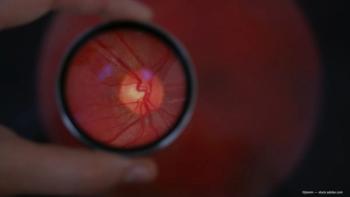
Proper surgical management can ease floppy iris syndrome
Proper management of cataract cases involving intraoperative floppy iris syndrome (IFIS) should keep surgeons from experiencing complications associated with the problem, reported Alan Crandall, MD, at the World Ophthalmology Congress on Thursday.
Proper management of cataract cases involving intraoperative floppy iris syndrome (IFIS) should keep surgeons from experiencing complications associated with the problem, reported Alan Crandall, MD, at the World Ophthalmology Congress on Thursday.
David F. Chang, MD, and John R. Campbell, MD, initially identified IFIS a couple of years ago and, through the American Academy of Ophthalmology, they issued a warning for the ophthalmic community about the cataract surgery problem.
The center of the IFIS controversy is the drug tamsulosin (Flomax, Boehringer Ingelheim Pharmaceuticals). The drug is the most commonly used medication to treat benign prostatic hypertrophy (BPH), a common urological problem that affects the prostate and the bladder.
Dr. Crandall, of the Moran Eye Center at the University of Utah, Salt Lake City, said that there are several medications available to treat BPH. These drugs fit into the alpha-1 blocker category, which induce outflow by relaxing the muscles in the bladder and the bladder neck. Tamsulosin is the most popular drug because it has fewer side effects.
"Flomax is different from the other drugs because it has a very high affinity and specificity for the alpha-1 receptor subtype, which is the predominate subtype for both the prostate and the bladder," explained Dr. Crandall. "It also turns out that the alpha-1 receptor is present in the iris dilator muscle."
The use of tamsulosin involves a triad of findings:
- The iris is floppy and tends to billow with normal flow within the anterior chamber.
- The iris tends to prolapse into the phacoemulsification handpiece and falls into the main and side-port incisions during surgery.
- The critical and concerning part of the problem is the tendency for the pupil to stretch during the surgery.
This combination leads to very difficult surgery and, in the original communication from Drs. Chang and Campbell, they were experiencing a 12.5% capsular tear rate.
Dr. Crandall presented some strategies for managing this surgical problem. He urged surgeons to:
- Avoid pupil stretching. This causes the iris to act abnormally.
- Reduce the phaco machine settings to low-flow settings: bottle height to around 70 cm; aspiration flow rate to around 25 mL/min or less; vacuum to 250 mm Hg or less.
- Use iris hooks in a diamond configuration.
- Use various available mechanical devices.
- Use an ophthalmic viscosurgical device (OVD).
Dr. Crandall added that recently, a prospective study, conducted by Dr. Chang along with nine other centers, found that managing IFIS as described has dropped the capsular tear rate to less than 1%.
Newsletter
Don’t miss out—get Ophthalmology Times updates on the latest clinical advancements and expert interviews, straight to your inbox.









































